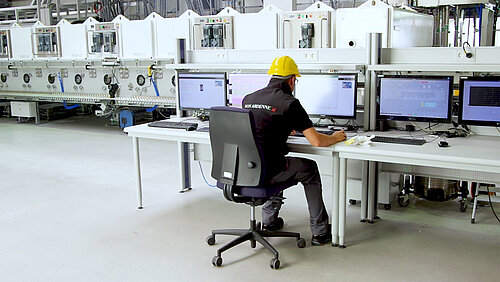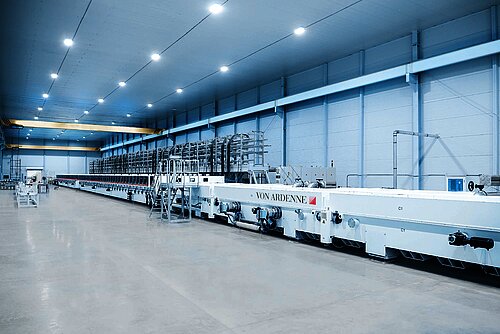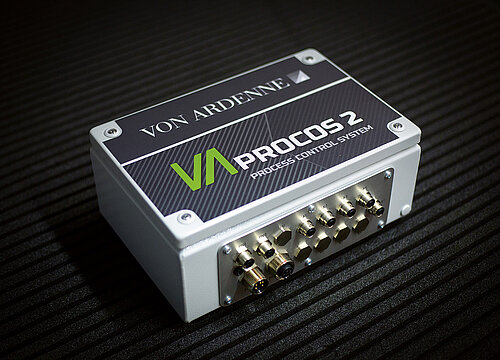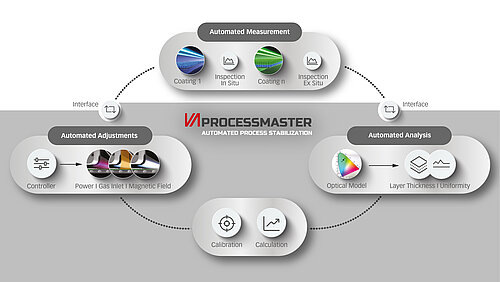The challenges of the market
Architectural glass coating is a mature technology with similar equipment and processes used by most players. As a consequence, this maturity of the market leads to significant cost pressure which can best be dealt with if the productivity of a specific coating line is high and a good share of products with a high added value is produced. In other words, higher profits can only be achieved if producers of coated glass are able to work at a minimum down-time and can control complex layer stacks with a small team of professionals.
In this article, we would like to show how data collection, data analysis and data processing can contribute to meeting the current market challenges in glass coating. For the last two decades, VON ARDENNE has been dedicated to optimizing process control through state-of-the-art sputtering components and automation. The resulting digital solutions are bundled under the name VA INDIGO, with a scope ranging from process support to digital services.
Why process control is necessary
Functional coatings often consist of multi-layered complex layer stacks that interact with each other to create the desired functionality of the surface. Therefore, a coating system for modern architectural glass features a multitude of sputter sources with various materials to create layer stacks with more than 10 individual layers that are needed for a Double-Low-E or Triple-Low-E coating.
The parameters that have to be maintained across the entire area of the glass are a homogeneous transparency and color fidelity, apart from the heat protection properties, of course. That means that there are high requirements for the process stability over a duration of four or more weeks, which is a typical time frame for a production campaign today.
The beginning of the road
In the 1990ies, VON ARDENNE was among the first to offer a plasma emission monitor that allows optical process control in an industrial environment. Many of the customers have initially applied the first-generation PEM05, then the VAprocos and now the VAprocos2 (see picture) process control system to enable transition mode sputtering from planar and rotatable targets.
In the evolution of the hardware and software of this process control system, other sensors have been included such as lambda probes and voltage control devices. Therefore, the system supports the combined operation of these additional sensors.
Building on this experience and combining it with other technical solutions provided by the market, VON ARDENNE is now implementing a unified process control system that provides automated feedback control. Before that, only a part of the process was stabilized (for instance with VAprocos), or the systems were not used in automated feedback mode, for example the BREIN system of Wolfgang Theiss.
In 2020, VON ARDENNE launched the VA PROCESSMASTER (see picture), a project to automate the coating process in two steps. The core of the system is a control algorithm, which uses optical information about the layer stack to determine if the layer thickness or layer thickness uniformity across the glass need to be adjusted to obtain the desired optical results. Since then, VON ARDENNE has been continuously improving the software and adding features to improve the usability and widening the scope of the VA INDIGO portfolio.
The next steps on the way to smart manufacturing
In the next step, the performance will be enhanced by adding automatic recipe changes from one coating product to another – or a process ramp-up after maintenance. Managing the production of complex layer stacks will be significantly simplified with the help of these process control features complemented by advanced sputtering components. This will lead to a more stable production and an increased uptime.
The above-mentioned solutions are tightly linked to the sputtering process. With regard to the final product quality control and the production costs, however, even more aspects of the system should be considered. For some years now, the term “Industrie 4.0” has been used to describe actions and tools that take advantage of the entire range of accessible data in a production system.
“We believe that three fundamental areas can be distinguished when referring to coating systems”, said Harald Hagenström, Vice President Glass at VON ARDENNE: process control as described above, statistical analysis of any type of production data to enhance product quality and reduce cost (sometimes referred to as a “big data” approach) and using system data to reduce maintenance cost and increase the up-time of coating systems by means of predictive maintenance.
The importance of components
Process control is a strong instrument to get the best results out of your production line. This means that all your process parameters can be optimized, such as gas inlet or magnet bar settings to control the resulting layer uniformity. The basis for achieving the best results and thus highest production output are state-of-the-art sputtering components such as magnet bars, end blocks and planar magnetrons.
A Chinese proverb says that ‘one chopstick can be easily broken while a bundle of chopsticks cannot’. If you apply this proverb to any kind of production equipment, you could argue that the more reliable components it has, the longer the equipment will last and the smoother will be the production.
Producers of coated glass who are using magnetron sputtering in their production process, can be provided with high-quality components needed for creating excellent coating results, no matter if they are using VON ARDENNE equipment or third-party systems. Among them are end blocks and magnet bars that are needed for magnetron sputter sources with rotatable and planar targets.
The components that are most relevant for the topic of this article are magnet bars. These are components that belong to rotatable magnetrons and are located inside the rotary target cylinder. They are needed to create and adjust the magnetic field and thereby influence the coating process. In order to enable that, they consist of many individual magnets. VON ARDENNE is working on a solution to make these magnets remotely adjustable and on integrating this functionality into the VA INDIGO portfolio.
Conclusion
In conclusion, it will take some more steps before we can reach the goal of smart manufacturing in glass coating. VON ARDENNE is exploring new concepts, architectures and components to advance the digitalization of the glass coating process even further. But on the road to the smart factory, it will be wise to join forces and cooperate across the board.
"We can achieve great benefits if suppliers and users work closely together" said Ronny Borchel, Product Manager Plasma Components at VON ARDENNE. "I would like to encourage everyone who is interested to contact us for further information.



